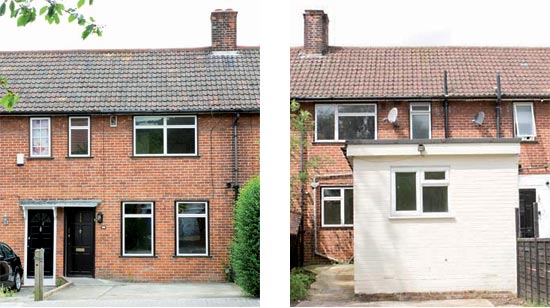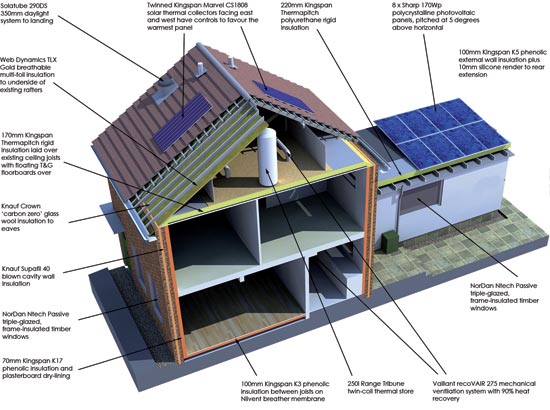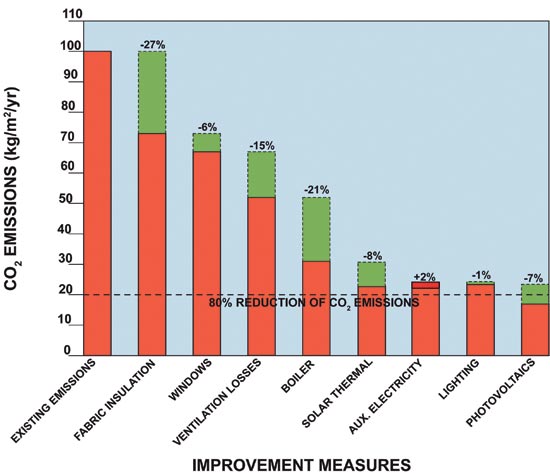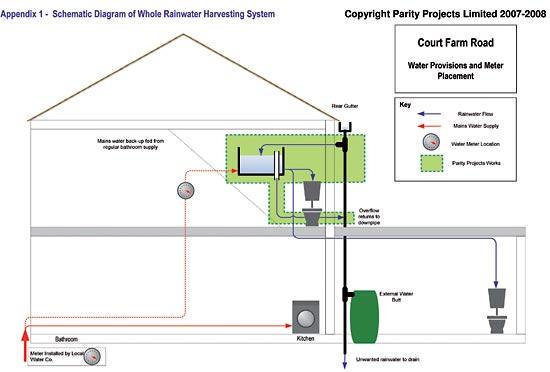Property: 3-bed, 1930s, mid-terrace, South London
Client: Hyde Housing Association
Architects: ECD Architects
ECD Architects approached Hyde Housing Association in 2007 with a proposal to undertake an exemplar retrofit project.
Retrofit initiatives to date have focussed primarily on installing individual renewables or other low-carbon technologies. Hyde and ECD therefore agreed that the aim of this project would be to establish the most effective overall package of retrofit measures necessary to achieve a 80% reduction in CO2 emissions, recommended by the Existing Homes Alliance, at a typical 3-bedroom mid-terrace house.
The project would include a post-construction 2-year monitoring period which would develop a full cost/benefit analysis, with a view to ascertaining the optimum expenditure. This would enable Hyde and others to make the more efficient and effective choices about how best to apply energy saving as part of large scale retrofit programmes.
The property
225 Court Farm Road is likely to have been built in the 1930’s as part of a large estate development. The external walls are of cavity wall facing brick construction and the original dwelling included suspended timber floors and pitched tiled roofs but no bathroom! Later improvements saw the inclusion of a first floor shower room, the replacement of open fires with a central heating system of gas combination boiler with radiators and the addition of a single-storey rear extension comprising a third bedroom and ensuite bathroom.
asdfasdf

asdfa
Fabric improvements over time have seen the addition of double glazing (though of poor quality) and 100mm loft insulation to the pitched roof, though the flat roofed extension included only 25 mm mineral wool insulation. A solid concrete floor replaced the timber in the kitchen and the strip out works found that the original water supply was via lead piping and an asbestos tank, with no stop-cock found on the premises. Further asbestos was found in the soffit boards.
Initial design proposals investigated the potential for a loft conversion at the property but this was eventually ruled out due to a lack of headroom. There is an imperative to enlarge the first floor shower room and further space is required for hot water storage and electrical equipment (inverters, dataloggers etc).
Performance prior to refurbishment
• The existing house had a SAP rating of 60, well above the national average of 48 and therefore presenting a significant challenge to achieve the 80% reductions.
• An initial ‘base case’ airtightness test was executed with which to compare the completed scheme and to highlight existing leakage points that need mitigation. The test revealed a surprising 9.16 m3/hr/m2 @ 50 pascals, which is better than current building regulation requirements. The windows were the source of the worst infiltration with poor seals leaking air badly, followed by incoming services penetrations and the loft access hatch.
• According to PHPP software, specific primary energy use (heating, DHW + auxilliary electricity) at the existing property is estimated to have been 414 kWh/m2/yr with CO2 emissions rated at 100 kg/m2/yr and space heating demand rated at 223 kWh/m2/yr.
Refurbishment priorities
• Obtain an overall 80% reduction in energy use, employing the most straightforward of improvements.
• Minimise heat losses from the building fabric
• Install an easily replicable, efficient form of space and water heating
• Reduce the energy requirements for lighting
• Utilise the most appropriate renewable forms of micro-generation

Reducing heat loss
Designed u-values
· Suspended timber floor – 0.2 W/m2K
· External walls – 0.15 W/m2K
· Pitched or flat roofs – 0.1 W/m2K
Floors and walls
• In the choice of insulation material, thermal performance and ease of installation has been favoured over embodied energy and material source considerations, although minimal GWP and ZODP credentials were pre-requisites.
• Phenolic foam insulation offers the best performance of any readily available panel and therefore has less impact on internal room dimensions where dry-lining is concerned – an important consideration for Hyde. Kingspan’s Kooltherm phenolic range was therefore selected for both suspended floors and external walls. For the main body of the house, insulation-backed K17 plasterboard dry-lining panels were specified, whilst for the rear extension external K5 wallboards with a silicone render finish provides the best solution.
Roofs
• For the pitched roof element, a number of other factors came into play rather then straightforward thermal performance.
-The loft is to be used for locating plant such as the proposed thermal store and mechanical ventilation unit, therefore access and available headroom were important factors, as was the poor condition of the existing roofing felt.
-Simultaneously, we were concerned about achieving good airtightness when recessed light fittings were introduced to the ceiling below.
A combination of insulation products were therefore selected – Kingspan Thermapitch, laid on an airtight vapour barrier over the existing ceiling joists, and Web Dynamics’ TLX Gold multi-foil lining the existing rafters and party walls. The rigid boards are laid to the depth of an existing central bearer (170mm), thus allowing a floating floor deck to pass freely across the loft area.
TLX Gold is the world’s first breathable multi-foil and the Court Farm Road project will be used as a case study and test-bed for both its ease of installation and performance in operation. This material will also allow the retention of the existing roofing felt and tiles by providing a secondary waterproof layer, as well as minimising the impact on headroom in the loft and reducing summer heat gains due to its reflective gold inner layer.
• For the rear extension roof Kingspan Thermapitch rigid polyurethane boards (220mm) were preferred, in conjunction with Knauf Carbon Zero glasswool in the eaves location.
Windows and Doors
• The existing double-glazed windows were shown to be the weakest building element during the airtightness test: they will be replaced with aluminium-clad NorDan Ntech Passive windows, which are triple-glazed with warm edge spacers and composite insulated timber frames, achieving an overall Uw-value of 0.7 W/m2K.
• Front and rear doors will also be replaced with insulated replacements with a Uw-value of 1.0 W/m2K.
Detailing and workmanship
Details were considered in terms of the abutment of insulation, avoidance of thermal bridging and continuity of the air barrier.
As well as communicating installation requirements on 1:5 detail drawings, ECD held a workshop on site with the contractor’s site team to explain the importance of their workmanship to these issues, together with background on how the building is intended to perform as a low-carbon dwelling.
To ensure a reasonably airtight envelope, the contractor kept a log and photographic record of all service penetrations through the external walls and roofs to ensure they are sealed effectively.
Heating
Ventilation and Heat Recovery
To provide controlled ventilation, a Vaillant recoVAIR 275 mechanical ventilation system is being retrofitted into the property. Mounted on the party wall in the loft space, the unit will extract air from the kitchen and bathrooms, reclaiming around 90% of the heat to pre-warm incoming fresh air which is then supplied to the living and bedrooms. In summer mode, a bypass extracts the air direct to outside
Space heating
With the above measures in place, the space heating requirements at the property are estimated to reduce from 17,238 kWh/yr to 2,410 kWh/yr – a drop of over 86%. With such low levels of heating required, tenant fuel bills will be significantly reduced. Capital cost, ease of retrofitting and ongoing maintenance requirements therefore become the most important driver in the choice of fuel source.
Systems considered but rejected
• Ground source heat pumps: are relatively expensive to install and need to be located in a substantial, and preferably sound-proofed, cupboard. Furthermore, to operate efficiently they work best in conjunction with an underfloor heating system, which in itself has inherent problems in a retrofit situation.
• Underfloor heating: The feasibility for underfloor heating was explored by ECD and Mears and found to be technically possible but only with a reduction in underfloor insulation levels and an increase in installation time and cost. When further confronted with a solid concrete floor in the kitchen, the concept was rejected in favour of a conventional wet radiator system.
• Heat pumps: Heat pumps require electricity to operate, which in the UK is particularly carbon intensive – more than twice the kgCO2/kWh than mains gas. Therefore to produce carbon reductions in comparison with an efficient gas condensing boiler, heat pumps need to achieve a Coefficient of Performance greater than 2.5 measured across the whole year – the recent trials at the Barratt EcoSmart show properties recorded a CoP of 2.6. Air source heat pumps are unlikely to improve upon these results at present and would also require underfloor heating.
• Biomass boiler: A biomass boiler was also ruled out by Hyde as it was thought to place an undue burden on the tenant to source and store a supply of wood pellets, and would again require additional plant space.
Selected system: condensing gas boiler & radiators
With these considerations in mind, the decision was made to upgrade the existing gas boiler for a more efficient condensing unit and the Vaillant ecoTEC system was selected, with low NOx emissions and programmable controls. This was relocated to a hall cupboard since the existing flue outlet position contravened modern guidelines.
Domestic Hot Water
The gas condensing boiler will also supply hot water to the property but will be supplemented by solar thermal collectors located on the pitched roof. The system is to be supplied and installed by Kingspan Renewables in conjunction with a twin-coil 250l Range Tribune thermal store located in the loft space. Two flat plate collectors mounted either side of the ridge will face east and west but will be controlled intelligently to favour the better performing panel as the sun tracks around the house to the south. It is hoped that 50-60% of the tenant’s hot water needs will be met by this system. All connecting pipework between boiler and thermal store will be well insulated to prevent heat transfer to the internal environment.
Power
A significant proportion of the property’s electricity load will be for lighting therefore the retrofit proposals will seek to minimise this component. Other major demands for electricity, eg for household appliance and entertainment use, are typically beyond the control of any RSL refurbishment scheme and down to tenant behaviour. The ‘Retrofit and Replicate’ exemplar project therefore concentrates on minimising electrical lighting loads through the installation of low energy lighting to every room.
Lighting
Unlike typical low energy lighting solutions, the use of compact fluorescents is avoided in favour of the latest in LED technology. Unlike CFLs, LED lamps contain no contaminants such as mercury or phosphor and can be safely disposed of or recycled. Although they are much more expensive currently, they are very robust and offer 50,000 hours of use (compared to 10,000 for CFLs or 3,000 for halogens) meaning no need to change then for at least 20 years! In this way, energy use is significantly reduced without the customary start-up delays and only a small reduction in efficacy. ECD worked with Gloucestershire-based specialist GreenLED to develop the layouts and specifications. GreenLED will supplied 3.7W Antares GU10 lamps for installation by the contractor, Mears, into standard recessed fittings.
Micro-generation
Despite all the carbon reduction measures described above, the scheme was still estimated to fall short of achieving the 80% target, largely because of its relatively good SAP rating at the outset.
Photo voltaics
Working with Solar Technologies, proposals for an array of eight panels located on the rear extension roof were developed. Bearing in mind the short lead-in time, product availability and the need for grant funding, Solar Technologies recommended Sharp 170W polycrystalline panels, to be laid at a pitch of only 5° to limit any impact on the neighbouring property. A single inverter has been located in the existing ‘electrical’ cupboard and a wall-mounted display will inform the incoming tenants of its electrical contribution.
Getting to an 80% reduction

The graph above shows the impact that each of the measures implemented at the property have on the associated CO2 emissions. The insulation measures alone account for over a quarter of the original emissions, or a third if the triple glazing is included.
The greater efficiency of the condensing boiler then takes the improvement to over 50%, after which the returns on investment are less dramatic.
Nevertheless, the introduction of MVHR and airtight construction should contribute a further 15%, with the solar thermal and LED lighting taking our overall reduction to 76%!
The photovoltaic contribution allows the refurbishment to easily achieve the target with a built-in contingency for actual performance in use.
The high levels of energy conservation and generation are reflected in the provisional EPC rating of 92, placing the property in the highest Band A.
Predicted specific primary energy use at the refurbished property is estimated at 67 kWh/m2/yr with CO2 emissions reduced to 17 kg/m2/yr and space heating demand reduced to 32 kWh/m2/yr. Fuel poverty should never be a concern for one lucky tenant!
Water conservation
Water efficiency
• Though driven primarily by low-carbon targets, the project offered an opportunity to incorporate other sustainable refurbishment measures. Water conservation measures are also a key interest for Hyde and the two bathrooms will subsequently be fitted with Twyford Galerie Flushwise (2.6l/4.0l dual-flush) wc’s, aerated basin taps, Mira Eco shower handsets and a low volume bath.
An alternative way of harvesting rainwater
• The project team did not consider conventional rainwater harvesting, stored underground and pumped up to a header tank, to be viable for a stand-alone property - primarily in terms of the installation and maintenance costs but also in terms of energy and carbon savings.
A recent study by the Centre for Alternative Technology (CAT) has proven that the embodied energy consumed in the manufacture of buried tank systems is never paid back through its life by the savings made from utilising rainwater.
However, ‘Retrofit and Replicate’ partners Parity Projects have experience of installing simple gravity-fed harvesting systems and have designed a proposal based around a filtered 318 litre tank located in the void above the stairs. The tank is fed directly from an external downpipe, requires no pumps and therefore requires no parasitic electricity and next to no maintenance. Parity Projects’ calculations indicate that virtually all of the water required for flushing could be supplied from the annual average rainfall locally. A meter on the back-up supply will determine actual annual mains water consumption.

Materials
External
Materials specifications generally reflects the environmentally-friendly aims of the project, for example:
• FDT Rhepanol pvc-free single-ply roof membrane to the rear extension
• Finnforest Thermowood fascia cladding boards
• Lindab Rainline steel guttering
These materials have been selected because their manufacture and processing avoids the use of toxic materials. Typically they are durable products that require minimal maintenance and can be easily recycled at the end of their life.
Internal
Internally, the focus has been on responsible sourcing and avoidance of materials prone to off-gassing wherever possible. This is especially important in a dwelling where air leakage and draughts are very low. Timber used throughout the house is either softwood or occasionally temperate European hardwood, with FSC or PEFC accreditation.
Natural products have been selected for floor finishes as far as possible, with Tarkett Marley Veneto XF linoleum flooring in the kitchen and an eco-wool carpet to bedrooms and hall areas supplied by the Alternative Flooring company. The latter has even been laid on a recycled rubber underlay!
The access door to the rainwater harvesting cupboard was fabricated in MDF for ease but the zero-formaldehyde Medite Ecologique was used in lieu of conventional fibreboard.
Landscaping and external works
In the garden and driveway the tenant has been provided with the tools to help with a greener lifestyle, for example:
• raised planter to encourage home-grown vegetables
• twin composting bins
• rainwater butt to store water for use in
the garden
• a rotary washing line
• recycle box storage
Decoration
Internal decoration has been carried out throughout the entire house post-refurbishment – paints were generously supplied by Dulux Trade from their Ecosure and Light & Space ranges. Working with consultants from their in-house team, the specifications have been selected to highlight their performance credentials, whether that be low VOC levels in the bedroom environments, improved durability and lifespan in the hallways or increased light reflectance in the living areas. The Dulux team will then benefit from the tenant feedback on the performance of these paint finishes over the two year monitoring period.
Post-occupancy Monitoring
n addition to carrying out the comprehensive eco-refurbishment, Hyde are providing the incoming tenants with an understanding of how to best maximise energy savings and to optimise use of the property.
The design team will then comprehensively monitor the property’s performance whilst in occupation, in order to give us a thorough understanding of what technologies best work in terms of CO2 savings, energy efficiency and cost effectiveness.
Working with Parity Projects, thermocouples are being installed across all wall and roof constructions. These temperature readings will be recorded and uploaded directly to a datalogger, together with ongoing electricity, gas and water usage. Furthermore, a heat meter linked to the output of the Vaillant ecoMAX condensing boiler will provide details of the actual energy used for space heating and supplementary hot water at the property. Uploading this information to a PC-based software package will allow continuous remote monitoring and analysis of the property’s energy use and emissions.
In addition to the quantitative data PPCR will undertake post-occupancy interviews conducted throughout the monitoring period to assess resident reactions to the eco measures employed and their impact on comfort and satisfaction. The refurbishment can greatly reduce carbon dioxide emissions, but another crucial question is: ‘What’s it like to live in?’ PPCR will conduct a complimentary exercise with a family living in a nearby similar but non-refurbished property as a comparator. They will discuss general aspects through a questionnaire type agenda with each household member able to contribute, for example:
· Does living here seem any different to another home of this type?
· Does the ‘ecohome’ present any requirements for lifestyle changes?
· Are there any aspects of the measures that are difficult to use/understand?
· Are there any measures you would like to change? Why?
· Do you think it would work for all tenants/families?
· What re the benefits of living in an eco-home?
Financial savings
Of equal importance to reductions in carbon emissions are the financial savings to residents resulting from the significant reduction in energy consumption. It is estimated that energy consumption will be reduced by up to 85% with a saving to the residents of around £600 per year as a result of the retrofit being carried out (at 2008 energy costs). This project will therefore make a major contribution to the growing problem of tackling fuel poverty.
At the end of the project a cost benefit analysis will be produced for each of the eco measures adopted. This information will be disseminated publicly and will specifically inform Hyde’s future stock investment and refurbishment plans.
Publications
• Sustainable refurbishment of Victorian housing, Yates, BRE Press, 2006
Further information
• Hyde Housing Association (www.hyde-housing.co.uk)
• ECD Architects (www.ecda.co.uk)
Disclaimer
GreenSpec accepts no responsibility or liability for any damages or costs of any type arising out of or in any way connected with your use of this web site. Data and information is provided for information purposes only, and is not intended for trading purposes. Neither GreenSpec nor any of its partners shall be liable for any errors in the content, or for any actions taken in reliance thereon.